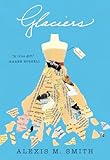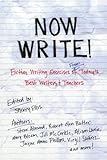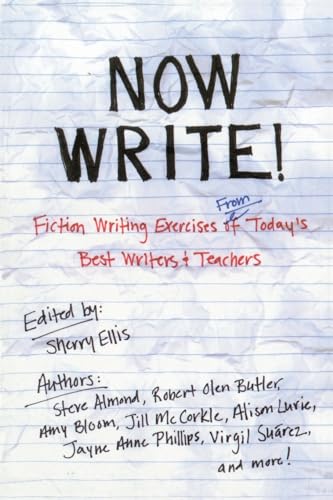Dear Writing Teacher,
How does a writer attach one scene to the next without saying “And then…”? I find myself stuck in one room or place forever because I can’t make the move to another place or time gracefully.
Sincerely,
Languishing in the Parlor
I love this question because it’s about the mucky parts of writing that are more difficult than you expect them to be. It’s often these micro-level mechanics that slow a writer down, make her feel like she’s oiling the rusty joints of robots rather than conjuring and exploring the lives of real people with meaningful problems. Fluidity is what I long for, anyway, when I’m working; I want to feel like I’m “inside” of my own text, participating in its unfolding in a way that is intuitive, natural, and enjoyable. Being overly conscious of transitions gives me a distancing, jerky feeling that is the opposite of fluid. Ugh. Just, ugh.
The nice thing about writing is that there are many different approaches, and readers are cooperative creatures with nimble minds: teach them early on how you like to transition, and they’ll learn to dance to the beat of your rhythm.
In thinking about this question, I took a look at how authors of the books I’ve read recently dealt with this technical challenge. To keep this manageable, my examples look at transitions within a section, scene or passage, but you can extrapolate these lessons to work for scene-to-scene problems, too.
 First, check out the opening of the svelte and lovely novel Glaciers, by Alexis M. Smith:
First, check out the opening of the svelte and lovely novel Glaciers, by Alexis M. Smith:
Isabel often thinks of Amsterdam, though she has never been there, and probably will never go.
As a child in a small town on Cook Inlet in Alaska, she saw volcanoes erupting, whales migrating, and icebergs looming at sea before she ever saw a skyscraper or what could properly be called architecture. She was nine years old, on a trip to her aunt’s with her mother and sister, the first time she visited a real metropolis: Seattle. She took it all in — the towering buildings and industrial warehouses, the train tracks and bridges, the sidewalk cafes and neighborhood shops, and the skyline along Highway 99, the way the city seemed to rise right out of Elliot Bay, mirroring the Olympic Mountains across the sound. The breadth and the details overwhelmed her, but soon she loved the city in the same way she loved the landscape of the north. Old churches were grand and solemn, just like glaciers, and dilapidated houses filled her with the same sense of sadness as a stand of leafless winter trees.
She began collecting postcards of other cities: Paris, London, Prague, Budapest, Cairo, Barcelona. She borrowed books from the library and watched old movies, just to get a glimpse of these other places. She imagined visiting them, walking the streets, sleeping in creaky beds in hostels, learning a few words of every language.
Now, this is summary, not scene, but it’s still instructive. Smith’s writing is crisp, somehow spare and lyrical at once, and throughout the novel it feels as if there’s something living beneath and beyond the sentences; implication runs deep. She’s pretty bold, I think, in the leaps she makes here: sometimes a paragraph break is all she needs to set off on a new idea, and she moves us into Isabel’s trip to Seattle with just a sentence. This passage ends here, and it’s followed by a space break. After this break she writes: “Isabel finds the postcard of Amsterdam on Thursday evening, at her favorite junk store, across from the food carts on Hawthorne.” The link between this and the last passage makes sense, but it’s subtle, and not explained outright.
Reading Glaciers reminded me that the movement between paragraphs can be surprising, and that space breaks can provide a useful exhale before you transition to a new time frame or narrative register. The trick is not to exploit such tools; once you’re done writing a draft, investigate your white-space, to make sure you aren’t purposefully gliding over a moment you’re too chicken-shit to write, and make sure your paragraphs have, if not a clear chain of events, at least an emotional and image-driven logic. It might help you to utilize this technique when you’re first getting a scene down: write what comes to you, and leave the muck of transitional sentences for later. It might turn out that you don’t need them.
 Now let’s turn to the deliciously plotted and clever crime novel Gone Girl by Gillian Flynn, which dazzled me from its first sentence. Here are a few paragraphs from 15 pages in, the opening of a chapter that begins in scene.
Now let’s turn to the deliciously plotted and clever crime novel Gone Girl by Gillian Flynn, which dazzled me from its first sentence. Here are a few paragraphs from 15 pages in, the opening of a chapter that begins in scene.
I swung wide the door of my bar, slipped into darkness, and took my first real deep breath of the day, took in the smell of cigarettes and beer, the spice of a dribbled bourbon, the tang of old popcorn. There was only one customer in the bar, sitting by herself at the far, far end: an older woman named Sue who had come in every Thursday with her husband until he died three months back. Now she came alone every Thursday, never much for conversation, just sitting with a beer and a crossword, preserving ritual.
My sister was at work behind the bar, her hair pulled back in nerdy-girl barrettes, her arms pink as she dipped the beer glasses in and out of hot suds. Go is slender and strange-faced, which is not to say unattractive. Her features just take a moment to make sense: the broad jaw; the pinched, pretty nose; the dark globe eyes. If this were a period movie, a man would tilt back his fedora, whistle at the sight of her, and say, “Now, there’s a helluva broad!” The face of a ’30s screwball-movie queen doesn’t always translate in our pixie-princess times, but I know from our years together that men like my sister, a lot, which puts me in that strange brotherly realm of being both proud and weary.
“Do they still make pimento loaf?” she said by way of greeting, not looking up, just knowing it was me, and I felt the relief I usually felt when I saw her: Things might not be great, but things would be okay.
 Now, what I get from this scene, aside from killer descriptions like “the spice of a dribbled bourbon,” is what Joan Silber, in her book The Art of Time in Fiction: As Long As It Takes, calls “selective concreteness.” Flynn isn’t including every little thing that Nick encounters as he enters his bar, she’s giving us only the details that matter to him, and that direct our gaze to what’s important to the scene and the book as a whole; in this case, it’s Nick’s familiarity with this space, and his relationship to his twin sister. It’s also interesting that Sue, the widow, is mentioned, because at its heart, this is a novel about marriage and marital dysfunction. I also notice how seamlessly Flynn moves between action of the scene, background information, and opinion. She transitions in and out of the present action as easily as your own mind does: you’re engaging with the external world, then thinking about something, then back to the world, and so on. Here, Flynn uses the visual image of Go’s glass-washing arms to move us into a general description of Go’s looks. It seems natural because it is natural: Flynn is inside of Nick’s perspective, noticing and commenting on what he would notice and comment on. If you’re truly inhabiting character, then transitions often happen automatically. This passage is also a reminder that dialogue can be a great way to bring us back to a present moment, especially if you’ve moved away from the scene to provide exposition or a flashback.
Now, what I get from this scene, aside from killer descriptions like “the spice of a dribbled bourbon,” is what Joan Silber, in her book The Art of Time in Fiction: As Long As It Takes, calls “selective concreteness.” Flynn isn’t including every little thing that Nick encounters as he enters his bar, she’s giving us only the details that matter to him, and that direct our gaze to what’s important to the scene and the book as a whole; in this case, it’s Nick’s familiarity with this space, and his relationship to his twin sister. It’s also interesting that Sue, the widow, is mentioned, because at its heart, this is a novel about marriage and marital dysfunction. I also notice how seamlessly Flynn moves between action of the scene, background information, and opinion. She transitions in and out of the present action as easily as your own mind does: you’re engaging with the external world, then thinking about something, then back to the world, and so on. Here, Flynn uses the visual image of Go’s glass-washing arms to move us into a general description of Go’s looks. It seems natural because it is natural: Flynn is inside of Nick’s perspective, noticing and commenting on what he would notice and comment on. If you’re truly inhabiting character, then transitions often happen automatically. This passage is also a reminder that dialogue can be a great way to bring us back to a present moment, especially if you’ve moved away from the scene to provide exposition or a flashback.
If you’re ever stuck in a scene, I suggest opening a favorite book, and seeing how the writer handles the problem. Flip to a crisis moment in the story or novel, and see how the events move along, how the author transitions out of one tense situation and introduces something else. Emulating that same structure might help you find your own.
Here are some other exercises and tactics that come to mind:
 1. Braiding Time
1. Braiding Time
I found this exercise in Now Write! edited by Sherry Ellis. It was created by fiction writer and teacher Cai Emmons, and I could just kiss her it’s so good. Basically, you write a scene of a character alone. The first paragraph, the character is doing something pretty rote and ongoing (washing dishes, etc.); the second paragraph flings the character into the future, without losing sight of the present; the third paragraph flings the character into the past (also with the present as a jumping-off point). The final paragraph uses all three time frames, present, past and future. It’s a great exercise for learning how to handle a character’s interiority, while also anchoring the character to a present moment. Also, each paragraph forces a transition. If the four-paragraph structure feels constraining, that might be revealing: where do you naturally want to transition? Pay attention to that.
2. The List
A student just gave me this idea last night in class. If you’re having trouble moving through a scene, consider first jotting down a list of what is physically and sensually in the scene/experience. You know: the smell of popcorn and cigarettes, the sister behind the bar, the widow with her crossword puzzle. By writing this list, you might find the scene’s shape, which will make it easier to see the material more fully. From there, imagine the next scene that follows, and write a list for that scene. I’m not yet certain how this will help with transitions, but I’ve got a hunch it will. Sometimes my fear of transitions has more to do with not knowing my world than anything else.
3. Do the obvious
When I’m truly anxious that I’m about to make a fool of myself on the page, it helps to just dive into that foolishness. Go ahead and write “and then…” to connect one action to the next. Write, “All of a sudden…” Write, “Out of nowhere…” Write, “A little while later…” Why not? Once you have your characters on the page, you can go back and see if you need to rewrite, cut, or what.
4. Figure out pacing
My last piece of advice is to stop and ask yourself what the time frame of your narrative is. Transitions are most painful to me in novel writing, and I think this is because I am usually covering more time, and it’s hard (and scary) to express that passage on the page. If you know that your narrative is the type that can handle, say, “Three weeks went by,” then it might be easier for you to figure out how to progress forward. The pace at which my story develops tells me a lot about how I need to start chapters, move from one scene to the next, and so on. For many, this might be a second-draft question, but it could help you to start wondering about it now. What I’m saying is: Transitions might be the problem, or they might just be the symptom of a problem.
Okay, that’s all I’ve got for you today. Now I need to figure out how to transition from writing this to working on my novel revision. Any suggestions gladly accepted.
Sincerely,
The Writing Teacher
Got a question? Send all queries about craft, technique, or the writing life to askthewritingteacher@gmail.com.




